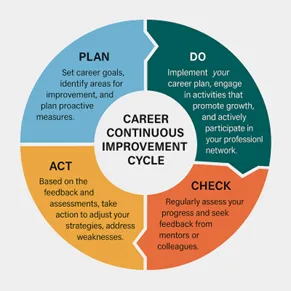Most people in our industry know what corrosion looks like. Metal that once had strength and structure starts breaking down. Slowly. Quietly. You might not notice it until it’s already impacted safety or reliability.
Careers can be like that too.
You start with momentum. You build experience. You take on bigger roles. Then something shifts – burnout, office politics, a company reorg, a new boss who doesn’t get it. Before you know it, the passion fades, and you start wondering, “What happened?”
Here’s the thing: corrosion and careers have more in common than you’d think. And if we manage our jobs the way we manage materials, we might hang onto both a little longer.
What corrosion teaches us about work
Corrosion is a natural process. Metal wants to go back to its original state—iron to iron oxide. That process speeds up when you’ve got the right (or wrong) environment. Typically, corrosion doesn’t happen overnight, but it happens. We manage corrosion by understanding the internal and external threats, design appropriate barriers and perform regular assurance activities. It takes energy and investment to manage corrosion.
Your career has the same setup. Internal threats include things like self-doubt, fear of failure or stress. External threats include things like impact of technology, layoffs, market swings, or bad leadership. If there’s no barrier in place, your career can start to corrode. Slowly at first. Then faster.
So how do we fight back?
Build your barriers
In corrosion management, we talk about barriers—things like coatings, cathodic protection, or material selection. In your career, your barriers look like this:
- Mentorship: Someone to give you perspective when things get messy
- Networking: Build relationships inside and outside of your company
- Understand how work happens: To be outstanding in your field, you need to spend time standing in the field.
- Continuous learning: Keeps your skills sharp and relevant
- Self-awareness: So you know when you’re burning out before it’s too late
- Boundaries: Protect your time, your energy, and your mental health
You don’t need to build a fortress. But you do need a layer of protection. Otherwise, little things—bad meetings, unclear goals, missed promotions—start to wear you down.
The cycle that gets people stuck
In corrosion, there’s a historical pattern: first, no one pays attention. Then something fails. Then we overreact. After a while, we calm down, learn a few things, fix a few things… until the cycle starts over.
Careers can follow a similar loop:
- Complacency: “I’m fine. Nothing’s wrong.”
- Crisis: “Why am I miserable all of a sudden?”
- Fix-it mode: Take a class, change roles, breathe again
- Forget-it mode: “That’s in the past, time for Autopilot”
The challenge is to avoid this unhealthy cycle and use a continuous improvement cycle instead
Use a continuous improvement loop for your career
Most folks in industry know the Plan-Do-Check-Act cycle. It’s a simple continuous improvement process. You can use the same approach to run your career.
- Plan: Set goals. Pick the skills you want to build.
- Do: Learn something. Say yes to new projects. Help others.
- Check: Ask for feedback. Look at what’s working and what’s not.
- Act: Adjust your path. Make changes before you have to.
It doesn’t need to be fancy. It just needs to be honest. Once a year, sit down and ask: Am I still going in the right direction? If not, do something about it.
Make your own luck
People say luck plays a big role in careers and it certainly can. But here’s the other truth: luck favors the visible, the ready, and the connected.
That means you can weight the dice in your favor.
- Build real relationships
- Show up—online and in person
- Be prepared when opportunity knocks
- Say yes even if it’s not perfect timing
Jim Collins called it “Return on Luck.” You can’t control when luck hits. But you can control how prepared you are when it does.
What happens if you don’t
A comparison between managed (in action) versus unmanaged (inaction).
 |  |
| Tank car | Rusted hull of a ship |
| Long career in service with appropriate corrosion management. A tank car went into service in the 1920s. It was still around in the 1990s; not because it was indestructible, but because people understood the threats, barrier and assurance. | For a time, everything was going to plan. Then there was a series of events with no management plan. Now it is washed up and corroding away. |
| About the photo – Personal photo from a railway museum in Australia https://nrm.org.au/collection/fuel-tank-tc8463/ | About the photo – Photo from Unsplash and should be OK to use under their license https://unsplash.com/photos/brown-ship-on-sea- during-daytime-QiL4uFz1wuc About the shipwreck – https://en.wikipedia.org/ wiki/Dimitrios |
Most careers don’t get the ‘train’ kind of care. People just assume they’ll last. Until they don’t.
Two outcomes usually happen with inaction: Best case: You get lucky. Things turn out okay.
- More likely: You look back wondering, Where did it go wrong?
- You can’t fix everything. But you can stay involved in your own future.
Final Thought
Corrosion is natural process. So is career drift. Both can be managed once you recognize the threats, establish proper barriers and routinely evaluate the performance. And both are easier to deal with before things fall apart, i.e. good news is bad news early.
“So visualize your current situation.” Understand your threats. Inspect the damage. Build the barriers. Call a mentor. Update your plan. And don’t be afraid to recoat when needed.
Rust never sleeps. Neither should you on your career.
A career isn’t just a job. It’s the full course of your working life—how your roles, skills, and choices stack up over time.
Think of it as:
- A series of connected jobs and experiences
- A pursuit of steady progress in your field
- The long-term story of how you grow and what you build
It’s shaped less by luck and more by the decisions you make along the way.
I am not a product of my circumstances. I am a product of my decisions.
Stephen Covey.

Plan: Set career goals, identify areas for improvement, and plan proactive measures.
Do: Implement your career plan, engage in activities that promote growth, and actively participate in your professional network.
Check: Regularly assess your progress and seek feedback from mentors or colleagues.
Act: Based on the feedback and assessments, take action to adjust your strategies, address weaknesses, and capitalize on strengths.
This article was developed by specialist Tim Bieri and published as part of the fifth edition of Inspenet Brief magazine August 2025, dedicated to technical content in the energy and industrial sector.

